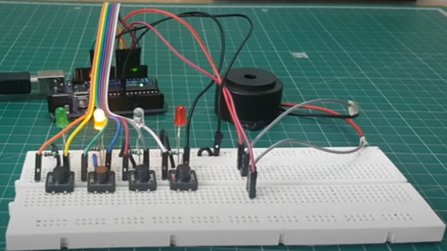Project No. 13 Creating TicTacToe Game With Arduino
1. Introduction:
Welcome to the world of Arduino game development! In this project, we
embark on an exciting journey to create a digital rendition of the timeless
game, Tic-Tac-Toe, using an Arduino board, an LCD display, and buttons. With
the combination of hardware and software, we will bring this classic game to
life, offering a fun and interactive experience for players of all ages.
Our objective is to build a dynamic and engaging Tic-Tac-Toe game
interface that allows users to strategically place X symbols on a 3x3 grid,
aiming to create a winning combination. To enhance the gameplay experience, we
will implement a cursor controlled by a button, enabling players to navigate
and select their desired positions on the grid.
2. Working:
Step1: Initialization:
The Arduino board initializes the LCD display and sets up the necessary configurations and libraries to communicate with it.
You design the game environment, including platforms, obstacles, and other elements that Mario will encounter. These elements will be displayed on the LCD screen. Create or obtain sprite images representing Mario in different states (standing, jumping, running, etc.). These images will be displayed on the LCD to animate Mario’s movements.
Step3: Player Input:
A push button is connected to the Arduino board as the input mechanism for controlling Mario’s jumps. When the button is pressed, the Arduino detects the input signal. The Arduino’s code implements the game logic. It constantly checks for button inputs and updates the position of Mario accordingly. When the jump button is pressed, Mario’s position is modified to simulate a jump.
Step4: Game Logic:
The Arduino code also includes collision detection. It checks if Mario collides with obstacles or platforms in the game environment. If a collision occurs, appropriate actions are taken, such as ending the game or awarding points.
Step5: Win condition Check:
The Arduino keeps track of the player’s score and updates it based on achievements within the game. You can implement multiple levels or challenges to increase the difficulty and make the game more engaging. If the game grid is full and no player has won, it's a draw. Check for a
draw condition and handle it accordingly.
Step6: Display Update:
Update the OLED display to reflect the current
state of the game. Display the X and O symbols in their respective positions,
highlight the active player's turn, and indicate the winner or draw.
Step5: Game Loop:
Provide an option to restart the game once it is finished. This allows
players to play multiple rounds without having to reset the Arduino board.
3. What is OLED display?
An OLED (Organic Light-Emitting Diode) display is a type of display technology that uses organic compounds to emit light when an electric current is applied. It is a self-emissive display, meaning it does not require a backlight like traditional LCD displays. OLED displays offer several advantages, including high contrast, wide viewing angles, and low power consumption.
In the context of the "Guess the Number" game with Arduino, incorporating an OLED display enhances the user interface and provides real-time visual feedback during gameplay. The OLED display will serve as a medium to show messages and information related to the game, such as the user's guesses, feedback on whether the guess is too high or too low, and victory or game over messages
An OLED (Organic Light-Emitting Diode) display is a type of display technology that uses organic compounds to emit light when an electric current is applied. It is a self-emissive display, meaning it does not require a backlight like traditional LCD displays. OLED displays offer several advantages, including high contrast, wide viewing angles, and low power consumption.
In the context of the "Guess the Number" game with Arduino, incorporating an OLED display enhances the user interface and provides real-time visual feedback during gameplay. The OLED display will serve as a medium to show messages and information related to the game, such as the user's guesses, feedback on whether the guess is too high or too low, and victory or game over messages
4. Things that you will get with models:
2. Well soldered circuits
3. PPT
5. Project price:
You can buy this project at price 1700 Rs.
You can also customize your project according to your requirement as below:
The price of this projects depend on the component used in the model, for example in the above model the component used is:
1. Arduino UNO
2. OLED display
3. Battery for power supply
4. Buttons
5. Resistors
6. LEDs
7. connecting wire
8. other small components
There are some other optional component available that you can remove or add it to the model according to your need, so the price of the project will decrease or increase according to price of component used in the project and coding.
In summery, you can tell us what functionalities and components that you want to add or remove from the model, so the price will change accordingly. If you have any question related to this project then contact me: click here
Basically you will get all this things that required to present this project in front of your external, teacher, for practical use at your home or to show off in front of your friends 😉😉,so if you want to buy this project then fill this google form: https://docs.google.com/forms/d/e/1FAIpQLSfDQvyFqN1iDLOFhGNB0KK_nEW1rZujUEdmvNNQNazXK4tAZA/viewform?usp=sf_link
Note: The image shown is a conceptual representation and may not accurately reflect the final design or features of the actual model. The actual model will be developed based on extensive research, engineering, and design processes to ensure optimal performance and user experience.
Feel free to contact me I am always here for you
About Us: click here
Contact Detail: click here
For delivery detail: click here
Telegram: https://t.me/arduinoproject1



Comments
Post a Comment